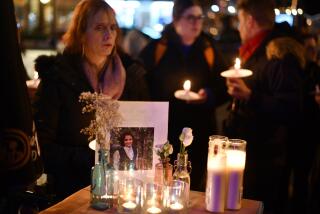Grieving Dad Harnesses Pain to Fight Bullies
- Share via
WOODSTOCK, Ga. — Bill Head clicked on his television and saw an evening news report that was chillingly familiar--scenes of tearful friends and family; children describing a pattern of bullying; a photo of a smiling teenage boy.
The youth was dying, punched by a student who had been taunting him.
The tragedy being played out just a few miles from Head’s home triggered terrible memories of a day four years earlier, and a telephone call that signaled a transformation of his life.
A co-worker of his wife, Rita, told him to come to her office, that she had fainted.
Racing there, he saw an ambulance and a sheriff’s cruiser. A knot tightened in his stomach as the sheriff approached.
“There’s been an accident,” he said.
But it was not an accident.
That morning, 15-year-old Brian Head, their only child, took a revolver into his classroom and cried out, “I can’t take it anymore!” Then he put it to his head and pulled the trigger.
So Brian ended the taunts of “fatso,” the signs taped to his back, the tripping, the sneak punches--and his own tears.
And so began his parents’ crusade.
Bullying Becoming More Violent
For many, bullies are unpleasant school memories, as common as recollections of unrequited crushes.
“Yet for all the sunny childhoods darkened by taunts and torments, research on the subject is scant--especially in the United States,” according to Education Week magazine in an article last year.
Those who have studied bullying--defined as chronic and systematic verbal and/or physical tormenting--say it seems to be growing and worsening in its impacts. And even in a time of greater societal attention to issues such as child abuse, bullying often is tolerated as a rite of growing up.
“It’s one of those underestimated problems,” said Dr. Gery LeGagnoux, a UCLA teacher and psychologist. “There has always been bullying, but I think it is escalating. Bullies have become more aggressive, with much more lethal techniques of carrying out their intimidation.”
He and others offer reasons for the escalation, ranging from movie and TV violence to gang activity.
Surveys of U.S. schoolchildren in recent years indicate 10% to 25% reported that they had been recently bullied, many to the extent that they began dreading school.
“People don’t realize how awful it is,” said Dorthea Ross, a Seattle-area psychologist who began studying bullying after tracing a boy’s mysterious stomach pain to his desire to avoid facing a bully at school.
In one research project she cited, children with leukemia said that rather than chemotherapy or spinal taps they had to undergo, “the worst pain was going back to school and being teased.”
Bullying victims often are faced with peer pressure against being tattletales and with educator indifference, LeGagnoux said.
He recounted watching secretly the recess activity of a young patient with a chronic back problem. When the boy tried to play kickball, he was punched in the stomach. When he complained to the coach, the coach asked: “What did you do to him?”
The coach told him to sit down, LeGagnoux recalled, and then several kids began taunting him and even throwing pebbles. When the boy began crying, the coach ordered him inside.
LeGagnoux said victims start feeling hopeless, even suicidal. Some school violence cases around the country have been linked to bullying, with victims using guns to fight back.
“The consequences can be quite severe,” LeGagnoux said. “And it’s increasingly evident that they are severe.”
Bill Head smiles as he describes Brian at age 15.
He was excited about learning to drive and was trying to master a stick shift. He wrote poetry, listened to music, played video games, fished and camped out with Dad--an affectionate, intelligent, easy-to-rear child.
On one outing, Head told Brian: “The greatest thing I could ever have is a son as good as you are.”
In previous years, Brian had complained at school and to his parents about teasing and bullying, mainly about his weight. They assured him things would get better as kids matured. “We didn’t realize how severe it was,” Head says.
Once, Brian had required stitches after being punched in the eye. The bully was removed from school.
In his last year, Brian indicated that school was going well. “I really thought he had turned a corner,” says his father.
But the bullying hadn’t stopped. Brian had simply given up.
Turning Grief Into Activism
Head, a 45-year-old industrial electronics engineer, says after the loss of their child, he and his wife felt a strong need “to do something. I could not stand by and let this go on to other children.”
They cleaned out their savings, sold a car, a computer and some furniture, and borrowed to sink more than $30,000 into an ongoing effort they call Kids Hope.
Working with Tom Brown, a counselor and child-care worker, they produced a video called “ . . . but names will never hurt me.” Head went on TV talk shows, promoting action in schools to end bullying; he talked to educators, lawyers, legislators and journalists; he researched bullying. He uses e-mail and three voice mails to exchange information.
Sadly, the calls have increased since Nov. 2, the day Head saw the TV news report.
It told of Josh Belluardo, a 13-year-old punched in the back of the head, allegedly by a boy who had been harassing him on the bus.
John Miller, a 15-year-old with a long record of discipline problems in school, faces trial as an adult on a murder charge.
Head sat in on one of his court hearings, watching “lives being destroyed”--those of the victim, the alleged bully, and their families.
Even the community at large.
“It’s been very tough on everyone around here,” says Carla Parker, a mother of three students who helped organize a group called Parents for Safer Schools. “We decided we didn’t want this to happen to anyone else.”
School board and state officials are also planning new initiatives.
“Maybe somebody needs to deal with this problem on a different level,” said state Rep. Chuck Scheid, who represents Woodstock and is working on a bill to address bullying.
Scheid consulted Head, who believes bullying should be treated as a violation of state crime laws against battery, stalking and threatening; that police should be called in such cases, and that schools should post warnings against bullying.
“It’s a civil rights issue,” Head says.
Unsmiling now, he says of his crusade: “This is not something I’m doing to honor Brian or try to keep him alive. It doesn’t make things easier. It doesn’t bring him back.”
A few lines of verse that the boy wrote, framed and hanging among photographs of Brian in a corner of the family’s living room, help explain why he does it:
The people with hurt, worry and pain,
Let their suffering be not in vain. . . .
(BEGIN TEXT OF INFOBOX / INFOGRAPHIC)
Facts About Bullying
Some common conclusions from those who have researched bullying:
* At least 10% of children say they are regularly bullied.
* Bullying takes place most often at school, away from adult supervision--in hallways, restrooms, the playground.
* Bullying begins in elementary school, peaks in middle school and drops but doesn’t disappear in high school.
* Most bullying is verbal rather than physical.
* Victims are taunted most often because of physical appearance.
* Children are uncomfortable and confused about bullying; they don’t like it but often say it’s done in fun.
Source: Education Week magazine / Associated Press
More to Read
Sign up for Essential California
The most important California stories and recommendations in your inbox every morning.
You may occasionally receive promotional content from the Los Angeles Times.













